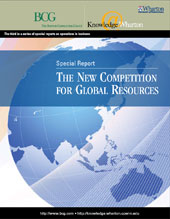Faced with an aging workforce and a growing demand for skilled workers in emerging markets like China and India, companies in the West are grappling with a talent crunch of unprecedented scope. According to experts at Wharton and The Boston Consulting Group, firms are increasingly questioning their workforce requirements and quality, training and development, and wage levels. Responses include over-hiring to meet future needs, upgrading training in concert with universities and in-house corporate schools, and extracting greater productivity through innovation.
Jim Hemerling, senior partner and managing director at BCG in San Francisco, says two factors are combining to exacerbate the so-called “war” for talent: the “significant aging of the workforce in North America, Europe and Japan [which is] shrinking the supply of experienced people in developed markets,” and the rise of “rapidly developing economies, or RDEs, driving up demand.”
Western companies are trying to retain people with 20 or 30 years of experience and who are heading into retirement age, even though they are expensive and have limited growth prospects, Hemerling says. At the same time, they want to hire people by the “tens of thousands” in the RDEs to both exploit the market opportunities and to leverage lower-cost talent by shifting some of their workforce requirements to those countries, he adds.
Hemerling recalls a client telling him, “We used to worry about what to do from a strategy standpoint. Then we worried about how — operations. Now, in addition to strategy and operations, we worry about who. Who is going to be there to get the work done? In fact, our biggest challenge is not what, it’s not how — it’s who.” Such companies, he notes, “have very aggressive growth plans, both for the domestic market but also for offshoring or best-shoring of their operations. Everyone is trying to do that at the same time.”
Foreign employers trying to access RDE workforces also face stiff competition from fast-growing local companies — “the new global challengers,” Hemerling says. BCG studies have tracked the competitiveness of these global challengers relative to Western companies both in the latter’s home markets and in developing countries.
“Many of these companies [from RDEs] are becoming major competitors and in some cases have become very attractive employers. People want to work for the local champions and the new global challengers developing in these economies.” As a result, he says, everybody is competing for the same talent pools.
Does a Talent Shortage Really Exist?
Peter Cappelli, a Wharton management professor, says he is skeptical about characterizing the emerging scenario as a talent shortage. He discounts the concerns that many express about rising wages in the RDEs. “Employers drive the agenda and the discussion of these topics and we take their description of what’s going on as being accurate, and I don’t think that’s right,” he says. At present, he sees no shortage of talent. “From an economist’s point of view, a shortage means that you can’t buy what you need or want at market prices. That’s not true in these countries.” As for rising wages, Cappelli argues that is exactly what employees want, and so do others who are concerned about living standards. “If wages don’t go up, standards of living stagnate.”
But talent shortages are real for employers looking to hire people with the “right education” and “10 to 20 years of management experience,” Hemerling says. “There are obviously billions of people, but there is a real shortage of leaders who can manage the younger people coming out of universities.” The shortages run across functions including product sourcing, marketing and even managing factories which increasingly require more efficient lean operations practices to offset rising costs.
The talent shortages can be moving targets for employers as they tend to “shift very rapidly” across work profiles, regions and time of year, Hemerling says. “For instance, up until a couple of years ago, there was almost an infinite supply of basic, unskilled labor in China.” Now, migrant workers are in short supply in China’s southern region of the Pearl River Delta, having switched loyalties to higher-paying high-tech industries that have moved in. The shortages “can materialize very quickly,” as happens with, for example, unskilled garment workers during the peak summer months, ahead of the Christmas shopping season, he adds. There is further pressure on seasonal production, as China recently modified its labor code to make it difficult for employers to hire and lay off workers depending on seasonality of demand, Hemerling says.
Companies Rework Their Approaches
Talent has become a strategic issue, as companies increasingly make decisions based on the availability of labor and skills — and face the challenges of finding and keeping good people. Four best practices are emerging, Hemerling says, referring to the findings published this year in a new book he co-authored with BCG’s Hal Sirkin and Arindam Bhattacharya titled, GLOBALITY: Competing with Everyone from Everywhere for Everything. According to the book, they include 1) recruiting for rapid growth; 2) developing deep skills and commitment in their people; 3) training and deploying new hires quickly for early results; and 4) allowing leaders to seize and build on opportunities. Companies that have embraced these practices include challengers rising up from RDEs such as Hisense, Johnson Electric, Embraer, Wipro, the Tata Group and ICICI, and some Western companies with operations in RDEs including Honeywell, Nokia, Cisco and Corning.
Hemerling says corporations, especially Western companies, have until now “essentially relied on poaching from other companies” — escalating talent costs in “a zero sum game.” But that is changing, with companies including Toyota and Motorola investing in training local talent in India and China, respectively, he says. Motorola University China, for instance, has 203 instructors who deliver 130 courses across subjects including Six Sigma business improvement and supply chain management. Toyota’s Technical Training Institute in Bidadi, near Bangalore, is honing local talent to meet its needs with 21 permanent faculty members who deliver a three-year training program, a strategy that also helps build employee loyalty.
According to Hemerling, the companies cited in GLOBALITY are addressing talent retention by building strong “umbrella brands” that put common faces to multiple brands across group companies. They combine that effort with career opportunities across these companies — both locally and globally — to make themselves more attractive to existing and potential employees. As part of the effort to build bench strengths, many firms operating in China and India are also over-hiring, which helps in offsetting attrition and planning for growth, Hemerling says.
In addition, firms are “accelerating leadership development” by “giving people more responsibility sooner, and identifying high-profile individuals and giving them more training and developmental experiences,” Hemerling says. To dispel fears of a glass ceiling, these companies are also elevating local employees to senior-level jobs, “sending a very powerful message that all the jobs are available to local people.” Furthermore, they institutionalize the empowerment of local operations by moving away from the old hub-and-spoke organizational model to a “multi-centered” structure, he says, citing as examples companies like IBM, Nokia, Cisco and SAP that have established global development centers in India and China.
Where Universities Fall Short
For the most part, however, universities in China and India are not keeping pace with the new demands, Hemerling says. “There is a huge range in quality of engineers coming out of these universities, from among the best in the world to others who [have] the equivalent of high school science.” The problem is not one of producing the required number of engineers or other graduates, but “ensuring they have the right set of skills.”
“In India, the big problem right now is the education system,” says Cappelli. “Employers can’t find the people with the requisite skills, and they find their basic education level is too weak.” He does, however, give the country bonus points for its “meritocratic approach in access to education.”
Training and development of these universities’ graduates is a big challenge, Cappelli notes. He traces the problem to a shift in assumptions about an employer’s responsibility. “A generation ago in the U.S., the assumption was that as long as employers had bodies, they would train them and manage them and develop them. Now, the assumption is that employers shouldn’t have to train or develop anybody, that they should be able to hire people who are ready to walk in the door today and contribute exactly what needs to be done, and they should be able to let them go as soon as they don’t need them any more.”
Cappelli emphasizes the need for companies to partner with universities to build talent appropriate to their needs. “The closer the education providers are to the employers, the better. Basically, what employers want is not in conflict with what educators want. Employers can provide the context where the students can see the connection between conceptual material and applied material. It actually ends up being a win-win.”
Cappelli points to three “best-known models” for such university-industry interface. One is Philadelphia Academies, a nonprofit that came about as a result of the race riots of the 1960s and that brings local high schools into partnerships with employers to build skill sets around industries such as health care and electronics.
Another is the North Carolina Community College System. “The schools organize training, aggregate it up from many employers and put together courses [that are] part of the requirements for getting a job in a company,” he says of the program that also dates to the 1960s.
The third is the Silicon Valley model, where he refers to institutes such as the Stanford School of Engineering, which offers a part-time management degree program for “high-level employees to advance their education while they are working.”
Necessity, the Mother of Innovation
In the present environment, one feature that companies in rapidly developing economies like India have working in their favor is a predisposition towards innovation when resources are lacking. “The operating environment in India and China causes different stresses, which can lead to different perspectives,” says Hal Sirkin, senior partner and managing director at BCG and head of its global operations practice. “That different perspective can give rise to innovative ways of thinking, not just about how to create products for foreign markets but about even a company’s domestic products.”
Sirkin expands that concept with the example of how a cell phone for the Indian market would call for a much lower-cost product design than one for the U.S. or the French market. “You might design it with less durability. You might make a trade-off to get 80% of the value for 30% of the cost,” he says. “But that might actually give you an insight into a U.S. product that could have 90% of the performance for 50% of the cost and could serve the lower end of the U.S. market.”
Ravi Aron, senior fellow at the Wharton School’s Mack Center for Technology Innovation, also sees innovation at work in response to competitive pressures. “Just as necessity is the mother of invention, it is also the mother of innovation,” he says. As an example, he refers to Indian information technology firm Wipro’s doing sophisticated work such as remote infrastructure management for companies in the United Kingdom and the United States from control rooms in Bangalore and Chennai.
Arun Maira, chairman of BCG’s Indian operations, points to process improvements implemented by Mumbai’s “dabbawallas” or lunch-box carriers, organized under the Nutan Mumbai Tiffin Box Suppliers Trust. “This cooperative organization is able to deliver thousands of hot-cooked meals from the homes of office workers in distant suburbs to their individual offices downtown without mixing up or losing a meal and then return the utensils to the workers’ homes in the afternoon,” he says. “The key process innovations are in the design and governance of the organization. Measurement has shown that its process reliability exceeds that of Six Sigma, all without using any computers to manage the supply chain, and by using the public transportation system to keep the costs of their service low.”
Arindam Bhattacharya, BCG partner and head of its industrial goods practice in India, sees changes in the ways corporate strategists respond to India’s numerous infrastructure constraints. “The sheer logistical and other challenges lead to business innovation,” Bhattacharya says. “Indian companies have learned to design their plants at a much lower capital cost than their counterparts in the developed world. Indians have an innovation culture. There is an inherent DNA to innovate.”
Supply Chain Talent Sourcing
Cappelli’s advice to all corporations grappling with talent challenges is to borrow the supply-chain model from manufacturing — an approach he advocates in his new book titled, Talent on Demand: Managing People in an Age of Uncertainty. “The big problem companies face is uncertainty — not knowing what the demand will be and what kind of talent you will need and how many people you will need in different jobs. This is a problem supply chain management has wrestled with for a while. The idea is to figure out how to get the desired level of talent without taking huge risks in terms of costs of recruiting, talent development, having excess employees and not having enough employees, and how to minimize those costs.”
According to Hemerling, increasing the level of automation in work processes and producing higher-value goods and services are among the ways companies are extracting enhanced productivity from their employees in China and India. “There is a natural movement toward higher-value products where the cost of labor is being driven up,” he says, citing industry in the Pearl River Delta and the Yangtze Delta in China as examples.
“When wages start to rise, employers make much bigger investments in the kind of things that improve productivity,” Cappelli says. Meanwhile, “U.S. employers [have] stopped training and developing people and haven’t paid any attention to who’s going to replace the people who are going to be leaving the workforce.”
He adds that corporate folklore also thrives on “myths” surrounding the desirability of a younger workforce. “If you look at the West, the population is aging a lot, and if you look at India, the population is getting younger. Is that a good thing? It’s not a good thing unless you are interested in lots of cheaper workers getting into the workforce.” It is not clear if China is at a disadvantage because India has a younger workforce. “The workforce in China has one of the most stable population distributions in the world.”
Cappelli points to how economists and other experts once viewed such workforce trends in the United States. “In the U.S. in the 1970s, the conclusion was that the slowdown and stagnation in U.S. productivity was because we had dumped so many young workers into the workforce,” he says. “If your workforce changes and gets younger, basically that means your workforce is getting less skilled, less experienced and less senior. It’s not obvious that’s a good thing.”
All the talk about Baby Boomers’ retiring is another myth, Cappelli says. The average age of the Baby Boomers is about 51 now, he says. Many are likely to keep on working beyond the traditional retirement age. “They’re probably going to be working longer than any generation before,” he says. It’s likely that “more people retired at age 65 in the previous generation than are likely to retire now.”
Bulking Up
Although companies such as IBM, Cisco and Citigroup have bulked up their Indian operations with large-scale hiring programs, Jim Andrew, senior vice president at BCG and leader of its global innovation practice, feels many Western companies are barely scratching the surface of the opportunity to access talent in India and China. “Hiring 10 or 20 or even 50 people in India is not fully leveraging the talent in those countries,” he says. “Hiring 500 or 5,000 people begins to tap into that talent.” Many companies don’t understand the magnitude of that opportunity “or what it takes to be an employer of choice for the highest-performing talent in those countries.”
Western employers also have to come to terms with the fact that wages will rise in India and China to levels where they may have to rework their outsourcing math, says Cappelli. While the average worker in India is still “incredibly cheap by world standards,” U.S. employers won’t want quite as many of those workers if they get uncomfortably expensive.
Cappelli warns that it would be wrong to assume that wages in India will continue to be a tenth of what they are in the United States. He also resists the corporate temptation to decry the trend of rising wages. “I wouldn’t call it wage inflation. It’s a natural process of rising standards of living,” he says. “Wage inflation is a bad thing, but raising your standard of living is not a bad thing. What does it mean to grow if we never make any more money?”



